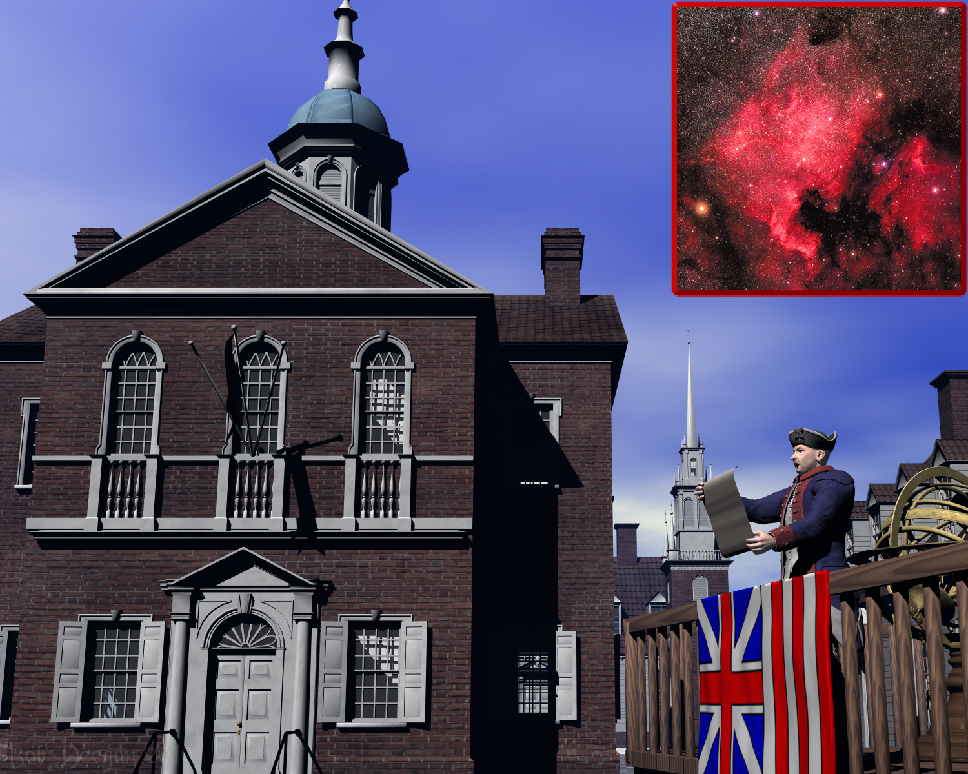
For the week including July 2, 2010

INDEPENDENCE DAY
In 1776, temperatures had already risen high in the colonies by the time July rolled around. Since their war with France, that had ended thirteen years earlier, the British had sought to extract much of the resources of the American colonies, both natural and financial, to satisfy their war debts. Britain’s force of arms promoted theft and repression; American protests were met by violence and ever more brutal repression. In March, armed resistance had expelled the British from Boston, but they would soon return with plans to crush the colonists once and for all. The Continental Congress gathered in Philadelphia with the hope to form a nation from the colonies. The task of drafting the Declaration of Independence fell to Thomas Jefferson who prepared a document now famous around the world. On July 4th, the final version of Jefferson’s Declaration was ratified, just as British armies were streaming ashore at New York harbor. The Congress had little time to ready the people of the new United States of America for the war of independence and they chose a special site for the first public reading of the Declaration. The observatory in Philadelphia’s State-House yard had been constructed to record and study the rarely seen Transit of Venus in 1769. Many of us took advantage of the opportunity to witness the Transit of 2004, but this once-in-a-lifetime event had a much greater scientific importance back then. The Transit’s ability to help determine the size of the solar system placed the Philadelphia observatory on the cutting edge of forward thinking exploration. On July 8th, John Nixon’s public reading of the Declaration of Independence from the observatory announced to the world that America was joining its nations.
Venus will transit the face of the Sun again in 2012, but there are some intersting things to see before then too. Among astronomers, a night of stargazing on the Fourth of July is deemed incomplete without stopping with binoculars or a telescope at a certain section of the sky to find another display that can help celebrate the birth of our country. In the constellation of Cygnus, the Swan, near Deneb, the bright star that marks the Swan’s tail, is a luminous patch just visible to the naked eye on a clear dark night. Shown in the photograph by Jason Ware at upper right, a small telescope brings out much more of its shape. With a suggestion of the gulf region and both the Atlantic and Pacific coasts of the United States, these glowing clouds soon came to be known as the North America Nebula.
For those who might be wondering about our illustration’s curious banner hanging in front of John Nixon, that was the first flag of the United States. Called the Congress Colors and later the Grand Union Flag, it combined the stripes inspired by the Sons of Liberty’s flag and the British Union Jack. (It would not be until 1801 that the British would add a red saltire “X” to their flag to commemorate their invasion and acquisition of Ireland.) While this nod to conservative colonials who didn’t want to sever ties to Britain pleased some, it did annoy the British East India Company whose ships flew an identical flag on the other side of the world. Our more familiar Stars and Stripes was formally adopted on June 14th, 1777, when Congress adopted the Flag Resolution which proclaimed: “Resolved, That the flag of the United States be made of thirteen stripes, alternate red and white; that the union be thirteen stars, white in a blue field, representing a new Constellation.”
Unless otherwise indicated, all content of this web site is the copyright of Robert Deegan and all rights are reserved.
For more information, or to comment, please contact: Bob@NightSkies.org